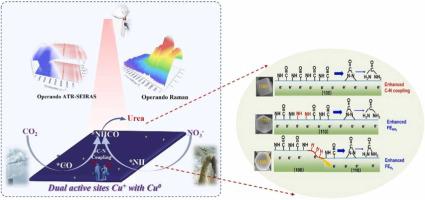当前位置:
X-MOL 学术
›
Appl. Catal. B Environ. Energy
›
论文详情
Our official English website, www.x-mol.net, welcomes your
feedback! (Note: you will need to create a separate account there.)
Identifying the facet-dependent active sites of Cu2O for selective C-N coupling toward electrocatalytic urea synthesis
Applied Catalysis B: Environment and Energy ( IF 20.2 ) Pub Date : 2023-09-09 , DOI: 10.1016/j.apcatb.2023.123265 Jiamin Zhao , Ying Yuan , Fei Zhao , Wei Han , Qing Yuan , Meimei Kou , Jinsheng Zhao , Chen Chen , Shuangyin Wang
Applied Catalysis B: Environment and Energy ( IF 20.2 ) Pub Date : 2023-09-09 , DOI: 10.1016/j.apcatb.2023.123265 Jiamin Zhao , Ying Yuan , Fei Zhao , Wei Han , Qing Yuan , Meimei Kou , Jinsheng Zhao , Chen Chen , Shuangyin Wang

|
Understanding the activity phases and reaction mechanisms at the atomic level is essential for the design of electrocatalysts. Herein we investigate the origin of the facet-dependent activity of model CuO catalyst for C-N coupling toward electrocatalytic urea synthesis. It was found that the activity of urea synthesis depends on the crystalline facets of CuO. The CuO (100) facet exhibits higher urea activity and selectivity than the (110) facet, with an average urea yield of 62.4 mmol·g·h at –1.5 V (RHE). By using Raman, UV–vis and XPS techniques, it was observed that Cu serves as active sites at (100) face of CuO, which promotes C-N coupling through synergistic interaction with Cu. Furthermore, the combined results of operando ATR-SEIRAS and DFT calculations demonstrate that the Cu-CuO (100) facet facilitates electrocatalytic C-N coupling between *CO and *NH intermediates due to the reduced energy barriers of hydrogenated *NO on the Cu-CuO (100) facet.
中文翻译:

识别 Cu2O 的面依赖性活性位点,用于选择性 CN 偶联以实现电催化尿素合成
了解原子水平的活性相和反应机制对于电催化剂的设计至关重要。在此,我们研究了模型 CuO 催化剂用于电催化尿素合成 CN 偶联的晶面依赖性活性的起源。研究发现尿素合成活性取决于 CuO 的晶面。 CuO (100) 晶面比 (110) 晶面表现出更高的尿素活性和选择性,在 –1.5 V (RHE) 下的平均尿素产量为 62.4 mmol·g·h。通过拉曼、紫外可见分光光度和XPS技术,观察到Cu在CuO的(100)面上作为活性位点,通过与Cu的协同相互作用促进CN偶联。此外,操作 ATR-SEIRAS 和 DFT 计算的综合结果表明,由于 Cu-CuO 上氢化 *NO 的能垒降低,Cu-CuO (100) 面有利于 *CO 和 *NH 中间体之间的电催化 CN 偶联。 100) 方面。
更新日期:2023-09-09
中文翻译:

识别 Cu2O 的面依赖性活性位点,用于选择性 CN 偶联以实现电催化尿素合成
了解原子水平的活性相和反应机制对于电催化剂的设计至关重要。在此,我们研究了模型 CuO 催化剂用于电催化尿素合成 CN 偶联的晶面依赖性活性的起源。研究发现尿素合成活性取决于 CuO 的晶面。 CuO (100) 晶面比 (110) 晶面表现出更高的尿素活性和选择性,在 –1.5 V (RHE) 下的平均尿素产量为 62.4 mmol·g·h。通过拉曼、紫外可见分光光度和XPS技术,观察到Cu在CuO的(100)面上作为活性位点,通过与Cu的协同相互作用促进CN偶联。此外,操作 ATR-SEIRAS 和 DFT 计算的综合结果表明,由于 Cu-CuO 上氢化 *NO 的能垒降低,Cu-CuO (100) 面有利于 *CO 和 *NH 中间体之间的电催化 CN 偶联。 100) 方面。





















































 京公网安备 11010802027423号
京公网安备 11010802027423号